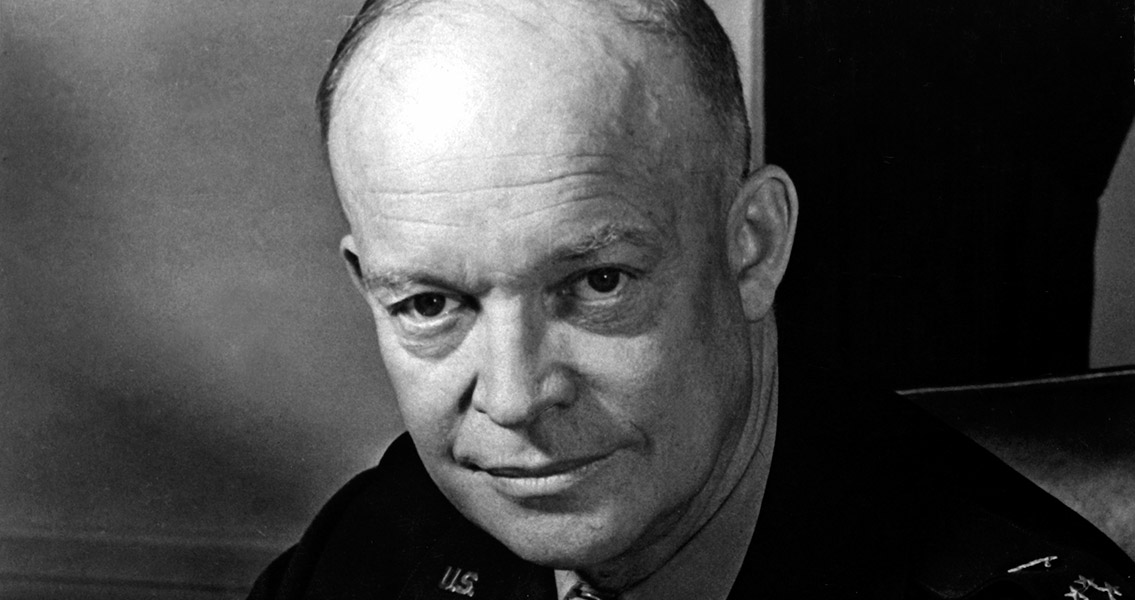<![CDATA[The 34th President of the United States and a hero of the Second World War, Dwight D. Eisenhower died on 28th March, 1969. His life had been one of two distinct personas, the military leader and the politician. Eisenhower was born in Denison, Texas, in October 1890. The third of seven sons, his family lived in a house close to the rail tracks where his father, David Eisenhower, made a living cleaning trains. After a year and a half, the whole family moved to Abilene, Kansas, where David took up a job working at his brother-in-law's creamery. In high school Eisenhower developed a reputation as an exceptional athlete, becoming a star of school baseball and football teams. He finished high school in 1909 and started working in the family creamery, using his wages to help pay his brother, Edgar's, university tuition fees. In 1911 Eisenhower won a place at the United States Military Academy at West Point, where his tuition fees would be paid for. A series of knee injuries brought Eisenhower's sports career to a premature end but he graduated in 1915, earning a commission as a second lieutenant in the US military. When the US entered the First World War, Eisenhower continued to be stationed in the USA, much to his disappointment, and he was not called onto go to Europe throughout the conflict. In the years between the two World Wars, he rose through the ranks of the military and served around the world, including a stint stationed at the Panama Canal, and several years serving as General Douglas MacArthur's aide in the Philippines. Following the German invasion of Poland, and the outbreak of World War Two, Eisenhower was recalled to the United States. Following the US entry into the war, Eisenhower was appointed to the army's war plans division, where he helped formulate plans for an Allied invasion of Europe. As the war ravaged Europe, Asia and Africa, Eisenhower continued to advance through the military ranks, forging a reputation as a formidable strategist. Nevertheless, his appointment in June 1942 as commander of US troops in Europe came as a shock, Eisenhower winning the rank ahead of a host of seemingly more experienced and qualified candidates. Perhaps hinting at his future career as a politician, Eisenhower's ability to persuade and mediate, as well as work effectively with others, played just as important a role in his appointment as his skills as a strategist. Eisenhower's role in planning the D-Day invasions and then commanding US forces in Europe is well acknowledged, and he returned to the US in 1945 to a hero's welcome. In 1950, he became the first Supreme Allied Commander of the North Atlantic Treaty Organisation. He worked in Paris, devoting himself to the difficult task of creating an international military organisation which could protect Europe in the case of Soviet aggression. Republican politicians started to try and persuade Eisenhower to become a presidential candidate, realising the war hero's popularity could extend to electoral victory. In 1952 he retired from the army, and began actively campaigning for the US presidency. In November of that year, he won a landslide victory. His consecutive elections show that Eisenhower was a popular president. Triumphs of his two terms include helping to negotiate a settlement in the Korean War, and striving to ease tensions between the superpowers during the early stages of the Cold War. At the same time, his presidency saw the US economy stabilise, enjoying a period of stable growth as the transition from war time to peace time economy was completed. The two terms also had their controversies however. It was a time when communist paranoia reached fever pitch, the peak of the Red Scare and McCarthyism occurring during Eisenhower's tenure. Senator Joseph McCarthy hurled accusations of treason and communist sympathies against other senators with little consideration for evidence and legal process. An Eisenhower backed immigration law enforcement initiative, known as Operation Wetback, was also hugely inflammatory. Up to a million people of Hispanic descent were forcibly removed from the United States and deliberately relocated to areas far south of the US border in a bid to make it impossible for them to return. A military style procedure, mistakes were made during Operation Wetback that saw US citizens removed as well as illegal immigrants. Subsequent reports have found that hundreds died either during or as a result of the deportations, with many now accusing the whole affair of being a violation of human rights. Following his retirement in 1961, Eisenhower relocated with his wife to their farm in Gettysburg. He passed away there in 1969. ]]>
Anniversary of Eisenhower's Death
